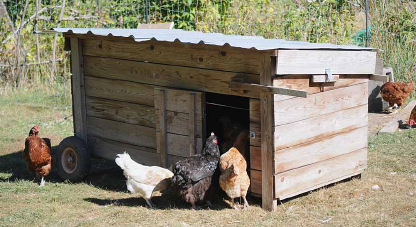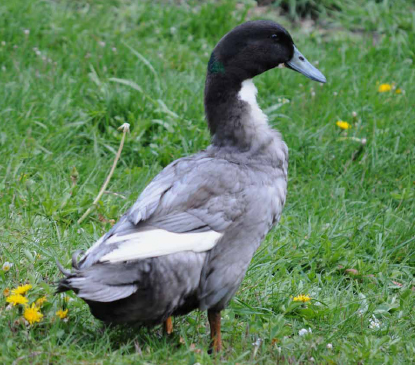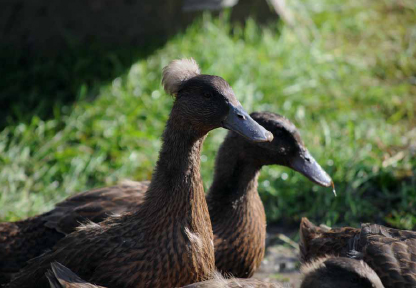
Everybody Look Busy — Here Come the Ducks!
Ducks are the perfect backyard livestock because they are so well-behaved.
— Eliot Coleman and Barbara Damrosch,
Four Season Harvest, Chelsea Green, 1999
“OH, BY THE WAY,” David said casually to me one fine April morning. “I ordered some ducklings.”
“Uh-huh?” I replied. We were in the middle of morning poultry chores, and I wasn’t really paying close attention. After a moment, I realized that David was standing still, waiting for a reaction. The light dawned.
“You mean live ducklings?” I was trying very hard to sound casual myself. I have to admit that I was somewhat shocked, having only a hazy memory of talking once, in passing, about someday getting ducks. Suddenly, it appeared, ducks were happening.
I picked up the baby turks I had inadvertently dropped and took a deep breath. “And when is the blessed event scheduled to occur?” I asked. Please don’t say it’s happening tomorrow, I prayed. David mentioned a hatch date about three weeks down the road, and suggested anxiously that I might want to start breathing again.
“Well,” I said, after regaining consciousness, “you’d better bring home some books from the library. I don’t know the first thing about raising ducks.”
Did I mention that I like to ask questions first? Since the little darlings were already ordered and presumably the eggs were in the incubator (not that I knew how long duck eggs had to be incubated), a slight nervousness was creeping up on me. By the next day, I admit, I was feeling fairly panicky.
When, I asked myself, was I going to find time to build yet another coop? For that matter, what kind of house do ducks prefer? Beyond having a vague impression that ducks don’t roost like chickens, I had no idea what their housing needs might be. What do ducks even eat? I had not a clue.
Although David had no luck finding a library book about raising ducks, he did eventually find a decent one at a thrift store in Seattle (see Appendix B). It was apparent that, as with turkeys, few helpful resources on ducks were available. I learned pretty quickly that ducks are quite different from turkeys and chickens. I know that sounds obvious, but bear with me.
It’s important to know that ducks tend to be fairly high-strung, compared with the much more mellow turkeys. Ducks hate stray light in their coops at night; it may even make them panic. The book David found, by Rick and Gail Luttmann, turned out to be a valuable source of information. Originally published in the 1970s, it was written for the beginning small-scale waterfowl enthusiast. Leafing through, I found a good example of a mobile duck coop and proceeded to build.
This first duck house is six feet long, three feet wide and about three feet high at the front of the sloping roof. I sized it for the eight ducks we were expecting. The book said that one and a half to two square feet per adult bird was optimum for laying ducks. The coop is on wheels and is fairly easy to move, even when it is full of ducks. We do move it around from time to time; for example, I like to move it into the shade of the old willow tree during the hot part of the summer. We also sometimes reposition it to be out of the wind if we’re expecting a severe windstorm.
One thing I would definitely do differently when building duck coops is to have solid wooden floors. Several of the poultry coops I built that first year had half-inch mesh hardware cloth floors: I assumed that this would make the coops easier to clean. However, I have concluded that, in most cases, wooden floors actually work better. Ducks are especially messy (she understated). They drink copious quantities of water, dabble in mud puddles all day long, and their poop is naturally very wet — and abundant. Of all our coops, theirs definitely require the most frequent cleaning. Although I usually toss in a layer of fresh bedding every other day, in an attempt to keep up with the moisture level between cleanings, we clean out the coops once a week or so. I wouldn’t wait much longer, if I were you. You don’t want to be impressed by how heavy that bedding is when you rake it out. This is especially true in the winter, when the birds spend more hours in their coops than during the long dry days of summer.
Incidentally, if I could give just one piece of advice about coop design in general, it would be to make them easy to clean. If you can put a removable door at the level of the coop floor somewhere, and make it wide enough for a steel rake to easily fit in the opening, trust me, you’ll be glad you did. It’s lovely to be able to open the door, rake out all the bedding onto a heavy tarp and haul it away to be composted. When you clean out coops frequently, as with ducks, it really makes sense to do all you can to make it a relatively simple chore.

Mobile coop.
One issue we’re trying to figure out with the duck coops is what to do about nest boxes. Based on my book’s recommendation, I put a nest box in one end of the coop, raised a little off the floor. The ducks did use it, but they also spent the night in it, having a great time kicking out all that nice dry bedding and filling the box with poop. They also laid eggs all over the floor of the coop. Still do, for that matter.
We have noticed that our ducks usually like to pick one corner of the coop to lay eggs in, although this depends on how much space there is and how many sleep in the coop. Ducks usually lay their eggs during the night or early in the morning, so by the time we let them out, almost all their eggs will already be there. A few seem to prefer to find an outdoor nest to lay in, and some days it’s felt like one big Easter egg hunt around here. However, they tend to go back to that same spot every day, so if you find it, you’ll know where to check the next day.

Blue Swedish drake.
The ducklings David ordered were of two varieties, Blue Swedish and Khaki Campbell. Yes, we had to learn the same lesson with ducks as with turkeys about the relative merits of having more than one breed at a time. In our defense, I can only say that we had to start somewhere. I mean, how would we know, before actually trying it, what breeds would work best for us? It was good to be able to compare egg-laying ability, personality, foraging ability and so on. We had no way of knowing that, within a year of getting our first ducks, we would discover a niche market for duck eggs in our area. This has completely altered our original ideas about why we might raise ducks at all. I tell you, once people found out that we had organically raised duck eggs, the demand has grown every year, and consistently outruns the supply.
By the way, of that first batch, we still have two Blue Swedish ducks; David calls them the Swedish Bikini Team. As I write this, in early 2013, they are going on five years old. They are beautiful, relatively calm for ducks, and although their egg-laying has slowed down over the years, they produced a respectable number of eggs last year.

Young Khaki Campbell ducks.
This is not a scientific assessment, but I think ducks are the smartest of the three kinds of birds we raise. I read recently that ducks are often used to train some kinds of herding dogs because they tend to stay together as a group and are consequently easy to move around. This is easy to observe when we escort the ducks into their coops at night. Take a step to the right, and the whole group of them moves to the left, and vice versa. I suspect this grouping behavior also accounts for the comparatively few predator losses our ducks have suffered. According to most of my sources, ducks are supposedly more predator prone than chickens or turkeys. This, to me, is a good example of how everyone’s situation is different. You really can’t take it for granted that what works for one person is going to be ideal for you, or that you’ll encounter the same problems as someone else. It would certainly be convenient if we could generalize that way, but my experience has been that many factors are likely to be unique to your situation, and you will simply have to figure them out as you go along.
David likes to tell people that the main reason we have ducks is for slug control. It’s true that I haven’t seen a slug anywhere near my kitchen garden since the first season we had ducks. They love slugs! Chickens will sometimes eat slugs, although I have only seen them eat very tiny ones. I remember that first spring, as I was loosening the soil in my kitchen garden beds, the ducks would line up, single file (I swear this is true) outside the garden fence, waiting for me to toss slugs over to them. Occasionally a duck would catch the slug in mid-air and, with head quickly tilted back, gulp it down in one fluid motion. Excuse me, but I mean, ugh.
The ducks are prolific layers. They also seem to me to have a shorter off-season than the chickens do, laying eggs for about ten months before slowing down in winter. In the spring, when egg production is heaviest, we sell whatever eggs the Alder Wood Bistro doesn’t need at several local retail stores. Khaki Campbells, generally reputed to be the champion egg-layers of the duck world, can easily lay over 300 eggs per year. Considering that they also moult in the fall and their egg production slows down, this is pretty amazing.